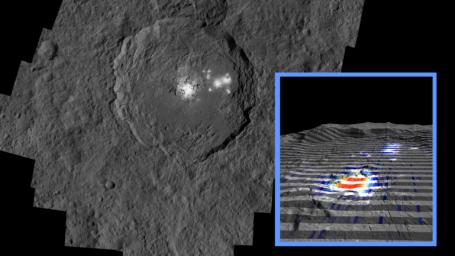
|
Occator Crater and Carbonates
- Click the image above for a larger view
- Full-Res JPEG (1118 x 629) (110.0 kB)
- Full-Res TIFF (1118 x 629) (943.4 kB)
Caption:
The center of Ceres' mysterious Occator Crater is the brightest area on the dwarf planet. The inset perspective view is overlaid with data concerning the composition of this feature: Red signifies a high abundance of carbonates, while gray indicates a low carbonate abundance.
Dawn's visible and infrared mapping spectrometer (VIR) was used to examine the composition of the bright material in the center of Occator. Using VIR data, researchers found that the dominant constituent of this bright area is sodium carbonate, a kind of salt found on Earth in hydrothermal environments. Scientists determined that Occator represents the highest concentration of carbonate minerals ever seen outside Earth.
Background Info:
Dawn's mission is managed by JPL for NASA's Science Mission Directorate in Washington. Dawn is a project of the directorate's Discovery Program, managed by NASA's Marshall Space Flight Center in Huntsville, Alabama. UCLA is responsible for overall Dawn mission science. Orbital ATK, Inc., in Dulles, Virginia, designed and built the spacecraft. The German Aerospace Center, the Max Planck Institute for Solar System Research, the Italian Space Agency and the Italian National Astrophysical Institute are international partners on the mission team. For a complete list of acknowledgments, see http://dawn.jpl.nasa.gov/mission .
For more information about the Dawn mission, visit http://dawn.jpl.nasa.gov .
Cataloging Keywords:
| Name | Value | Additional Values |
|---|---|---|
| Target | 1 Ceres | |
| System | Main Belt | |
| Target Type | Dwarf Planet | Asteroid |
| Mission | Dawn | |
| Instrument Host | Dawn | |
| Host Type | Orbiter | |
| Instrument | Framing Camera (FC) | |
| Detector | ||
| Extra Keywords | Color, Crater, Infrared, Thermal | |
| Acquisition Date | ||
| Release Date | 2016-06-29 | |
| Date in Caption | ||
| Image Credit | NASA/JPL-Caltech/UCLA/MPS/DLR/IDA/IAPS/INAF | |
| Source | photojournal.jpl.nasa.gov/catalog/PIA20694 | |
| Identifier | PIA20694 | |
